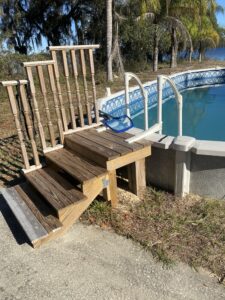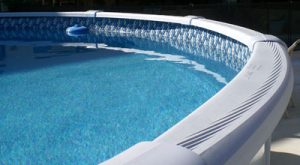With above-ground swimming pools, you get a few choices regarding how you can get in and out of them. These are called ladders or steps.
In Orlando, all types of steps and ladders for above-ground pools are popular.
LADDERS VERSUS STEPS FOR ABOVE-GROUND POOLS
When buying an AG pool as a package, it will always come with something that can get swimmers up and over the pool’s wall both going in the water and exiting it. In most cases, this will be a basic A-frame ladder.
A ladder for an above-ground pool is simply rungs that you step on that go up to the top of the pool’s wall, a small platform at the top, and then rungs that you step on to lower into the water inside the pool.
“Steps” for above-ground pools are a bit of an upgrade and usually have to be added to the pool package with an extra cost.
Steps for AG pools will be rungs going up to the top of the pool’s wall and are connected with a backing. The platforms of each rung (that you step on) are usually both longer and wider than just a ladder. After a small platform at the top of the pool’s wall, those same longer and wider platformed rungs go down and into the water of the pool.
As a general rule, pool steps are bigger, safer, and cost more than pool ladders.
THE DIFFERENT TYPES OF LADDERS AND STEPS FOR ABOVE-GROUND POOLS
A A-frame ladder
This is the standard and most common type of pool ladder. It simply has rungs outside of the pool from the ground going up, a small platform that sits on the pool’s top rail, and then rungs going down into the water all the way to the bottom.
This ladder makes an “A” shape and that’s why it’s called an a-frame ladder.
B In-pool only or deck ladder
This ladder only has a small platform that sits on a top rail of the pool, and then has rungs that go into the water inside to the pool’s bottom.
With this type of ladder, you need to have a deck outside of the pool for top entry.
C Pool steps
Just like a staircase, actual steps (not just thin rungs) will go up from the ground outside of the pool to a top platform that sits over the pool’s top rail, then steps will continue down into the water all the way to the floor of the pool.
Full pool steps going from ground to pool bottom are the biggest and usually the most expensive option for getting into an above-ground pool.
D Ladder/steps combo
With this, you have a ladder on the outside of the pool with rungs going from the ground up to a small platform at the top. And steps continue into the water going to the pool’s bottom.
E In-pool steps only
Just like the in-pool ladder, this only has steps going into the water of the pool and nothing outside.
This type of pool steps require a deck attached to the outside of the pool for top entry.
F In-pool wedding cake steps
Only inside of the pool, it starts with the first step being small, then each step gets longer with more area as they go down into the pool. The longer steps wrap around making half-circle shapes getting bigger as they get deeper.
With small to bigger steps going from top to bottom, these pool steps look like a multi-layered wedding cake.
THINGS TO KNOW ABOUT STEPS AND LADDERS FOR ABOVE-GROUND POOLS
1 All ladders for above-ground pools are safety ladders
Any ladders (or steps) for above-ground pools with an outside portion (not in-pool only) MUST be safety ladders.
This means that the rungs are made to lock upward or shielded in some way so they cannot be climbed when secured.
For most of the less expensive ladders, the rungs are designed to be lifted upward and locked in place so kids (and dogs) cannot climb up them.
Safety ladders are not as important closer to downtown Orlando as most homes will have fenced-in backyards. When you go further out and into the Central Florida country, there are fewer yards that are fenced.
2 Steps and ladders have weight ratings
America is known for having some pretty big people. And Orlando is no exception to that. Most pool ladders/steps can handle a fair amount of user weight, but bigger people may need more support.
Standard a-frame ladders for above-ground pools will have a weight limit or rating of 300lbs or 350lbs and some upgraded ladders will go to over 400 pounds.
Steps typically support more weight than ladders. Most steps support from 400 lbs all the way to 600 lbs depending on the model and cost.
NOTE: Some need the maximum weight and size for getting into the pool. For this, I recommend building a permanent outside step and deck structure from wood or concrete.

3 Steps and ladders have to be assembled
With the exception of some wedding cake-type steps (which are all one piece), both steps and ladders come in parts and have to be assembled.
NOTE: Professional pool installers will NOT assemble or install pool ladders. This is where many slip and get injured, so no one will take that responsibility.
4 You can put the ladder/steps anywhere around the pool that you want.
No one area of an above-ground pool is better than the other for where you put the ladder. So. Set the ladder/steps in a good spot for traffic from the house or deck to the pool.
5 Most steps and ladders have to be bolted to the top of the pool or deck
For nice stability, it’s usually a good idea to bolt the top platform of the ladder to a pool top rail. And if you have a deck, screwing the in-pool ladder supports to the deck is needed.
TIP: Make very sure that you bolt or screw the ladder/steps down using only stainless steel bolts/screws. Everything else may rust badly and not be able to come apart when it’s time to change the liner.
6 Install the ladder/steps when the pool is at least half full of water
Most ladders go in when the pool is being installed. You want to wait for the pool to have enough water in it so the liner is set well and has a lot of water weight at the bottom BEFORE placing the inside ladder/steps on the pool’s floor.
7 Ladders/steps have to be weighted down
The part of the ladder or steps sitting in the water of the pool will want to float. This is not good as you want the steps/ladder to be very stable and not move.
People use all kinds of things to weigh down their steps. I am a fan of using pieces of sand-filled and capped PVC pipes and attaching them with zip ties.
8 Some steps/ladders will have handrails. Some will not.
Take an inventory of the elderly or immobile pool users that you may have with your pool. You may want to get a ladder or steps with one or two handrails to help people get in and out of the pool.
Tip: For extremely immobile pool users, I recommend having a wood ladder and deck built for accessing the pool. With this, you can make the entry as big, wide, and stable as is needed.
It will cost more, but someone who is not comfortable with getting into a pool probably won’t bother getting in, even if they really need to.
